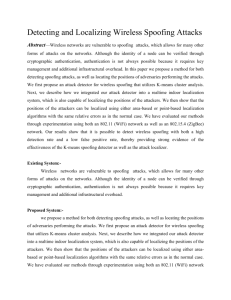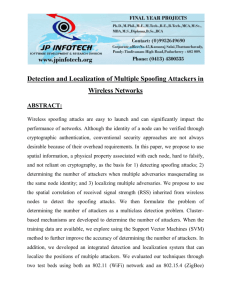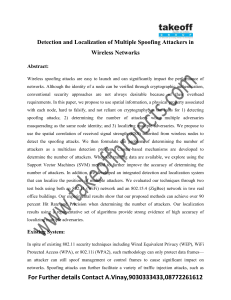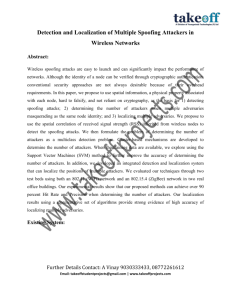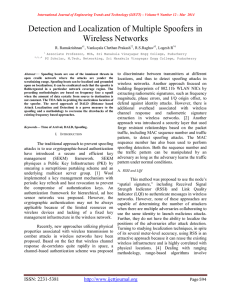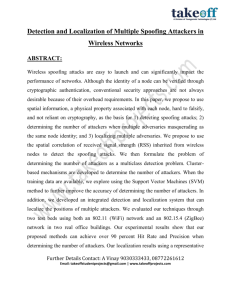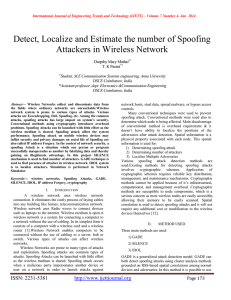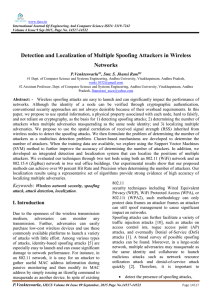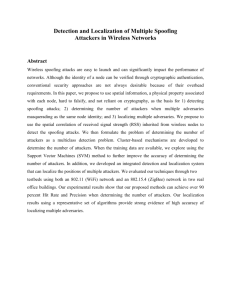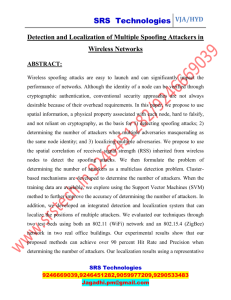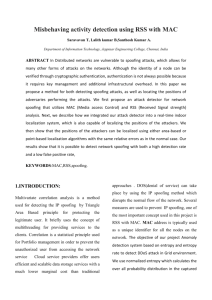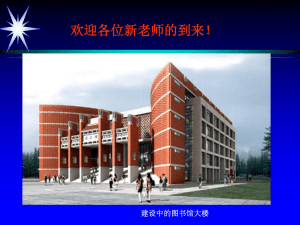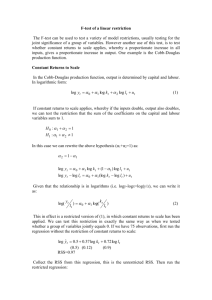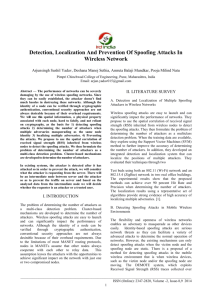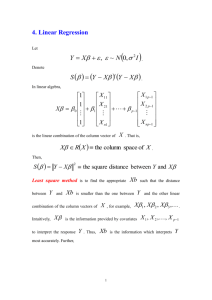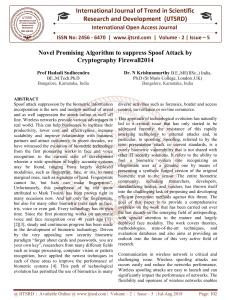Detection and Localization of Multiple Spoofing Attackers in
advertisement
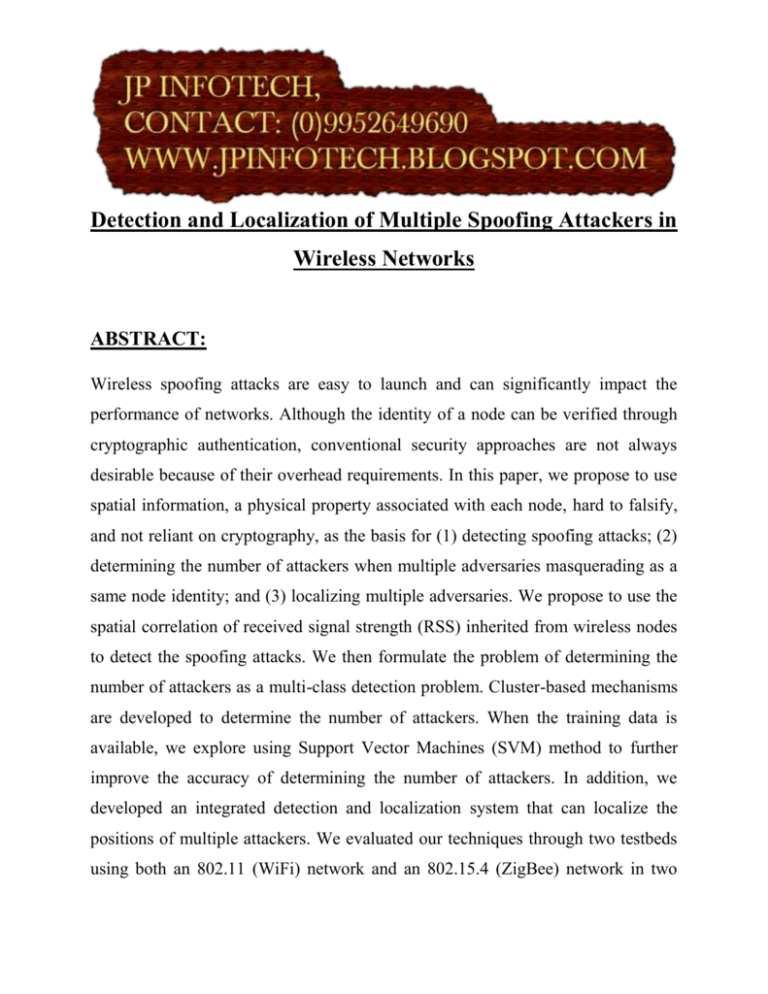
Detection and Localization of Multiple Spoofing Attackers in Wireless Networks ABSTRACT: Wireless spoofing attacks are easy to launch and can significantly impact the performance of networks. Although the identity of a node can be verified through cryptographic authentication, conventional security approaches are not always desirable because of their overhead requirements. In this paper, we propose to use spatial information, a physical property associated with each node, hard to falsify, and not reliant on cryptography, as the basis for (1) detecting spoofing attacks; (2) determining the number of attackers when multiple adversaries masquerading as a same node identity; and (3) localizing multiple adversaries. We propose to use the spatial correlation of received signal strength (RSS) inherited from wireless nodes to detect the spoofing attacks. We then formulate the problem of determining the number of attackers as a multi-class detection problem. Cluster-based mechanisms are developed to determine the number of attackers. When the training data is available, we explore using Support Vector Machines (SVM) method to further improve the accuracy of determining the number of attackers. In addition, we developed an integrated detection and localization system that can localize the positions of multiple attackers. We evaluated our techniques through two testbeds using both an 802.11 (WiFi) network and an 802.15.4 (ZigBee) network in two real office buildings. Our experimental results show that our proposed methods can achieve over 90% Hit Rate and Precision when determining the number of attackers. Our localization results using a representative set of algorithms provide strong evidence of high accuracy of localizing multiple adversaries. EXISTING SYSTEM: • Ingress / Egress Filtering: • Ingress – An ISP prohibits receiving from its stub connected networks packets whose source address does not belong to the corresponding stub network address space • Egress – A router or a firewall which is the gateway of a stub network filters out any packet whose source address does not belong to the network address space. DISADVANTAGES OF EXISTING SYSTEM: • Allows Spoofing within a stub network • Not self defensive • Effective only when implemented by large number of networks • Deployment is costly • Incentive for an ISP is very low PRPOSED SYSTEM: • The proposed System used Inter domain Packet filters (IDPFs) architecture, a system that can be constructed solely based on the locally exchanged BGP updates. • Each node only selects and propagates to neighbors based on two set of routing policies. They are Import and Export Routing policies. • The IDPFs uses a feasible path from source node to the destination node, and a packet can reach to the destination through one of its upstream neighbors. • The training data is available, we explore using Support Vector Machines (SVM) method to further improve the accuracy of determining the number of attackers. • In localization results using a representative set of algorithms provide strong evidence of high accuracy of localizing multiple adversaries. • The Cluster Based wireless Sensor Network data received signal strength (RSS) based spatial correlation of network Strategy. • A physical property associated with each wireless device that is hard to falsify and not reliant on cryptography as the basis for detecting spoofing attacks in wireless networks. ADVANTAGES OF PROPOSED SYSTEM: • Damage Reduction under SPM Defense is high • Client Traffic • Comparing to other methods the benefits of SPM are more. • SPM is generic because their only goal is to filter spoofed packets. MODULES: • Blind & Non-Blind Spoofing • Man in the Middle Attack • Constructing Routing Table • Finding Feasible path • Constructing Inter-Domain Packet Filters • Receiving the valid packets MODULES DESCRIPTION Blind & Non-Blind Spoofing: Spoofing detection is to devise strategies that use the uniqueness of spatial information. In location directly as the attackers’ positions are unknown network RSS, a property closely correlated with location in physical space and is readily available in the wireless networks. The RSS readings at the same physical location are similar, whereas the RSS readings at different locations in physical space are distinctive. The number of attackers when there are multiple adversaries masquerading as the same identity. Man in the Middle Attack: Localization is based on the assumption that all measurements gathered received signal strength (RSS) are from a single station and, based on this assumption, the localization algorithm matches a point in the measurement space with a point in the physical space. The spoofing attack, the victim and the attacker are using the same ID to transmit data packets, and the RSS readings of that ID is the mixture readings measured from each individual node. RSS-based spatial correlation to find out the distance in signal space and further detect the presence of spoofing attackers in physical space. Constructing Routing Table: The channel frequency response is sensitive to each multipath. An impulse in the time domain is a constant in the frequency domain, and thus a change to a single path may change the entire multiple tone link of Network. In wireless networks classes that provide automatic reconfiguration of APs, adjusting power levels and channel assignments to optimize coverage while minimizing contention between neighbors. The RSS readings over time from the same physical location will belong to the same cluster points in the n-dimensional signal space. Finding feasible path (Attack Computation): Converting the large dataset into medium format for the computation purpose. In this medium the rows consists of http request and columns consists of time for a particular user (IP address). Received Signal Strength Indicator Formula, The RSS stream of a node identity may be mixed with RSS readings of both the original node as well as spoofing nodes from different physical locations. Constructing Inter-Domain Packet Filters: The clustering algorithms cannot tell the difference between real RSS clusters formed by attackers at different positions and fake RSS clusters caused by outliers and variations of the signal strength. The minimum distance between two clusters is large indicating that the clusters are from different physical locations. The minimum distance between the returned clusters to make sure the clusters are produced by attackers instead of RSS variations and outliers. Receiving different Transmission Power: The transmission power levels when performing spoofing attacks so that the localization system cannot estimate its location accurately. The CDF of localization error of RADAR-Gridded and ABP when adversaries using different transmission power levels. In detection mechanisms are highly effective in both detecting the presence of attacks with detection rates over 98% and determining the number of network. DATA FLOW DIAGRAM: Select Network SVF Connect Oriented MAC Address Verify SVM Network Data Using Cluster Grouping Node Connectivity Dos Attack Spoofing Prevention Data Cluster Based Network NIC Data Connectivity Spatial Correlation of RSS Attack Validity Deploy Network Wi-Fi Activity Data Restriction Cluster Based Network Check Point Source User Destination User Static Cluster Attack Countmeaure Data Failed Cluster Measuring Dos Attack Node Data Locate SILENCE Mechanisms Attack Evaluation Mobility Cluster SYSTEM CONFIGURATION:HARDWARE REQUIREMENTS:- Processor -Pentium –III Speed - 1.1 Ghz RAM - 256 MB(min) Hard Disk - 20 GB Floppy Drive - 1.44 MB Key Board - Standard Windows Keyboard Mouse - Two or Three Button Mouse Monitor - SVGA SOFTWARE REQUIREMENTS:- Operating System : WINDOWS XP Front End : C#.NET TOOL : VISUAL STUDIO 2008 Database : SQL SERVER 2005 REFERENCE: Jie Yang, Yingying Chen, Wade Trappe and Jerry Cheng, “Detection and Localization of Multiple Spoofing Attackers in Wireless Networks”, IEEE TRANSACTIONS ON PARALLEL AND DISTRIBUTED SYSTEMS, 2012.
